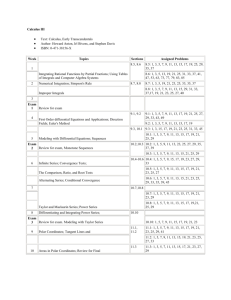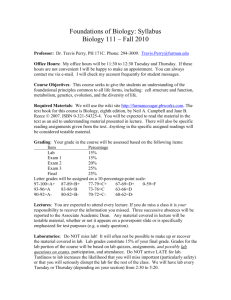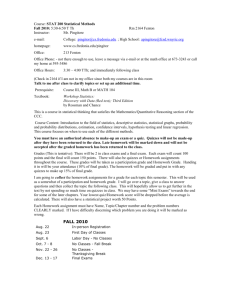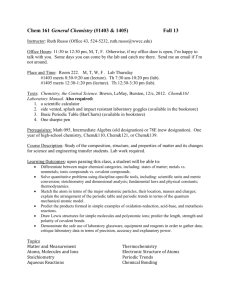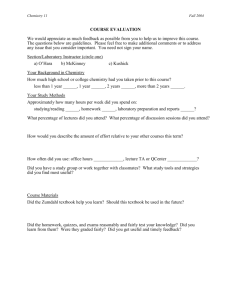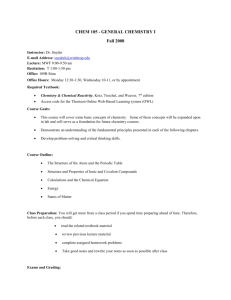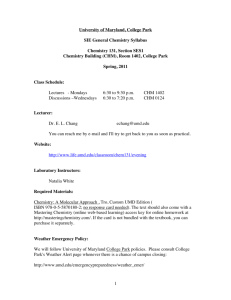CHEM 5710 - chem.usu.edu
advertisement
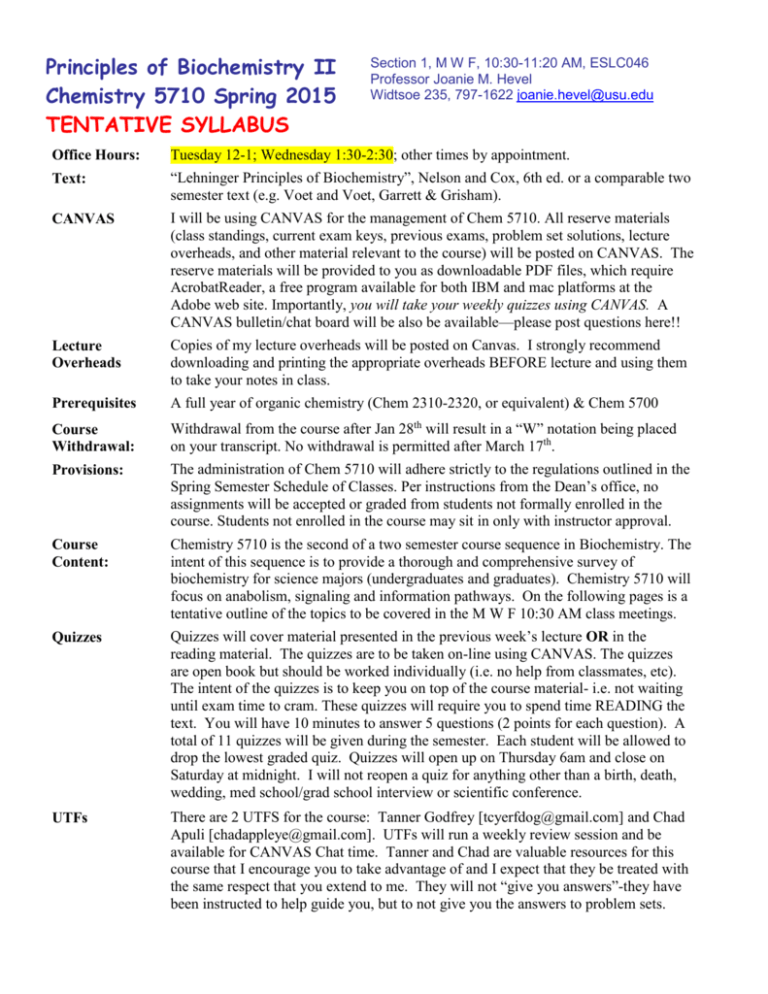
Principles of Biochemistry II Chemistry 5710 Spring 2015 TENTATIVE SYLLABUS Section 1, M W F, 10:30-11:20 AM, ESLC046 Professor Joanie M. Hevel Widtsoe 235, 797-1622 joanie.hevel@usu.edu Office Hours: Tuesday 12-1; Wednesday 1:30-2:30; other times by appointment. Text: “Lehninger Principles of Biochemistry”, Nelson and Cox, 6th ed. or a comparable two semester text (e.g. Voet and Voet, Garrett & Grisham). CANVAS I will be using CANVAS for the management of Chem 5710. All reserve materials (class standings, current exam keys, previous exams, problem set solutions, lecture overheads, and other material relevant to the course) will be posted on CANVAS. The reserve materials will be provided to you as downloadable PDF files, which require AcrobatReader, a free program available for both IBM and mac platforms at the Adobe web site. Importantly, you will take your weekly quizzes using CANVAS. A CANVAS bulletin/chat board will be also be available—please post questions here!! Lecture Overheads Copies of my lecture overheads will be posted on Canvas. I strongly recommend downloading and printing the appropriate overheads BEFORE lecture and using them to take your notes in class. Prerequisites A full year of organic chemistry (Chem 2310-2320, or equivalent) & Chem 5700 Course Withdrawal: Withdrawal from the course after Jan 28th will result in a “W” notation being placed on your transcript. No withdrawal is permitted after March 17th. Provisions: The administration of Chem 5710 will adhere strictly to the regulations outlined in the Spring Semester Schedule of Classes. Per instructions from the Dean’s office, no assignments will be accepted or graded from students not formally enrolled in the course. Students not enrolled in the course may sit in only with instructor approval. Course Content: Chemistry 5710 is the second of a two semester course sequence in Biochemistry. The intent of this sequence is to provide a thorough and comprehensive survey of biochemistry for science majors (undergraduates and graduates). Chemistry 5710 will focus on anabolism, signaling and information pathways. On the following pages is a tentative outline of the topics to be covered in the M W F 10:30 AM class meetings. Quizzes Quizzes will cover material presented in the previous week’s lecture OR in the reading material. The quizzes are to be taken on-line using CANVAS. The quizzes are open book but should be worked individually (i.e. no help from classmates, etc). The intent of the quizzes is to keep you on top of the course material- i.e. not waiting until exam time to cram. These quizzes will require you to spend time READING the text. You will have 10 minutes to answer 5 questions (2 points for each question). A total of 11 quizzes will be given during the semester. Each student will be allowed to drop the lowest graded quiz. Quizzes will open up on Thursday 6am and close on Saturday at midnight. I will not reopen a quiz for anything other than a birth, death, wedding, med school/grad school interview or scientific conference. UTFs There are 2 UTFS for the course: Tanner Godfrey [tcyerfdog@gmail.com] and Chad Apuli [chadappleye@gmail.com]. UTFs will run a weekly review session and be available for CANVAS Chat time. Tanner and Chad are valuable resources for this course that I encourage you to take advantage of and I expect that they be treated with the same respect that you extend to me. They will not “give you answers”-they have been instructed to help guide you, but to not give you the answers to problem sets. Chemistry 5710, Spring, 2014 Class assignments, In-Class Discussion & Critical Thinking Problem Sets: Critical thinking and creative problem solving are invaluable skills for students of all fields. Like Chem 5700, Chem 5710 is an upper division course designed to arm you with the knowledge necessary to address technically challenging problems. Over the semester we will have 3 types of activities: 1) class assignments (graded), 2) in-class group discussions (not graded) and 3) take-home critical thinking problem sets (graded). The goal of these assignments is to promote problem solving that requires you to put together what you have learned in order to effectively address a problem that you have not been directly exposed to previously or to identify deficiencies in your current thought processes. Class assignments: on Friday at the end of class, we will pose a problem(s) related to the previous lecture material. You will have the weekend to synthesize an appropriate answer; answers should be submitted through CANVAS by Sunday at noon. These short assignments provide you with the opportunity to express your understanding of a subject in written form-a skill that is becoming increasingly sought after by employers. It also gives you a chance to practice answering the kinds of questions I typically ask during an exam. They will also give me a better idea of how the class is grasping the material. There will be 6 class assignments worth 5 points each. In-class discussions: Occasionally we will break into groups in class to study a topic related to the current lecture material. They are designed to help you understand the course material from a different perspective. Although I will make any worksheets available to students who are not present in class, it will be difficult to recapitulate the experience on your own so I highly recommend that you attend lectures. These will not be graded. Critical Thinking Problem Sets: Some class discussions will segue into a research problem set that will be due approximately one week after the class discussion. The problem sets are meant to give you practice at applying the course information (versus regurgitating it). A significant amount of effort will be required to finish the Research Problems and will likely require you to use on-line databases, read articles from the primary literature, etc. Because you will have a week to complete these, I will expect narratives that show your ability to use correct grammar/spelling. A total of 4 problem sets will be given. Each problem set is worth 50 points. Each day an assignment is late 10 points will be deducted from the total point value. Recommended problem sets from the text: Recommended problem sets from the text book will be provided periodically for the students. Participation is 100% voluntary and the problems will not be graded. It is highly recommended that all of the students work these problems carefully as many of them will resemble the style of questions on the exams. p. 2 of 7 Chemistry 5710, Spring, 2014 Exams: One mini EXAM (30 minutes, 50 points) will be given after the first 2 weeks to make sure you are on target, and four hourly exams (100 points each) will be given during class on the dates indicated on the course schedule. The comprehensive final exam will be worth 150 points. The exam formats (i.e. short answer, short essay, problem solving, matching) will be similar to the exams given in past years with the exception that there will more multiple choice questions on the final. I strongly encourage you to work the past years exams and questions at the end of the chapters in the text as part of your exam preparation. Given the limited time frame for an exam, I will not be expecting a complete grammar-correct narrative—your answers do, however, have to be understandable. Make-up exams will only be allowed for students that can demonstrate a documented birth or death in the family or a documented illness or presence at a scientific conference or interview. Family vacations do NOT qualify as a reasonable excuse. You must contact me by email one week prior so I can make arrangements for a make up exam. Assessment Imbedded questions in the final will be used to address if learning objectives are being met. Grading: **There will be NO EXTRA CREDIT awarded in this class. Critical Thinking Problem Sets (total of 4) 200 points Class assignments (total of 6 @ 5 pts each) 30 points On-line quizzes (11, drop 2 lowest) 90 points One miniexam (30 minutes) 50 points Four hourly exams .................................................................................... 400 points Comprehensive Final exam ...................................................................... 150 points Total ......................................................................................................... 920 points General breakdown of grading scale is as follows: 100-90% A through A89.9-80% B+ though B79.9-70% C+ through C69.9-60% D+ through D- In accordance with the Americans with Disabilities Act, reasonable accommodations will be provided for all persons with disabilities in order to ensure equal participation in Chem 5710. In cooperation with the Disability Resource Center, reasonable accommodation will be provided for students with disabilities. Please meet with the instructor during the first week of class to make arrangements. Alternative format print materials, large print, audio, diskette or Braille, will be available through the Disability Resource Center. p. 3 of 7 Chemistry 5710, Spring, 2014 Class schedule Wee k 1 2 3 4 5 6 7 8 9 10 11 Da y Date Topic Chapter, Lehninge r Quiz M 1/5 No class W 1/7 F 1/9 M 1/12 W 1/14 F 1/16 M 1/19 W 1/21 F 1/22 M 1/26 W 1/28 Photosynthesis Class Assignment #1 Carbohydrate biosynthesis Review of Class Assignment #1; Carbohydrate biosynthesis Carbohydrate biosynthesis/Lipids Mini EXAM/ Lipids (Hevel out of town) No classes MLK Day Lipids Critical Problem set #1 DUE In-Class Discussion # 1 Lipids / Amino acids Class Assignment #2 Review of Class Assignment #2 Amino acids Amino acids 19 1 F 1/30 catchup M 2/2 Exam 1 W 2/4 F 2/6 M 2/9 W 2/11 F 2/13 T 2/17 W 2/18 F 2/19 M 2/23 W 2/25 F 2/27 M 3/2 DNA Technologies DNA Technologies Class Assignment #3 Review of Class Assignment #3 DNA Technologies DNA Technologies In-Class Discussion #2 Biosignaling Biosignaling Critical Problem set #2 DUE Biosignaling In-Class Discussion #3 Biosignaling Class Assignment #4 Review of Class Assignment #4 Biosignaling Hormonal Regulation Hormonal regulation catchup Critical Problem set #3 DUE Exam 2 W 3/4 Genes & Chromosomes 24 F 3/6 Genes & Chromosomes 24 M 3/9 SPRING BREAK W 3/11 SPRING BREAK F 3/13 SPRING BREAK M 3/16 DNA metabolism 20 20 20 2 21 21 3 21/22 22 4 9 none 9 9 12 5 12 12 12 6 23 23 23 7 none none 25 p. 4 of 7 8 Chemistry 5710, Spring, 2014 12 13 14 15 W 3/18 F 3/20 M 3/23 W 3/25 F 3/27 M 3/30 W 4/1 F 4/3 M 4/6 W 26 26 26 27 27 Protein metabolism/ Regulation 27/28 4/13 Regulation of gene expression 28 W 4/15 Regulation of gene expression 28 F 4/17 4/20 Exam 4 Regulation of gene expression In-Class Discussion #4 Regulation of gene expression review for final Critical Problem set #4 DUE 4/22 4/24 9 27 4/10 W none 26 F F FINA L 25 M M 16 25 4/8 DNA metabolism DNA metabolism Class Assignment #5 Review of Class Assignment #5 RNA metabolism RNA metabolism Exam 3 (Hevel out of town) RNA metabolism (Hevel out of town) RNA metabolism (Hevel out of town) Protein metabolism Class Assignment #6 Review of Class Assignment #6 Protein metabolism Protein metabolism 10 none 28 28 Final 9:30-11:20am p. 5 of 7 11 Chemistry 5710, Spring, 2014 EXPECTATIONS Much of the raw information in this class you may have seen before, perhaps in another class. However, this is a 5000 level class, which means that you should begin to apply raw information to solve problems. YOUR JOBS 1) Come to Class Prepared a) download notes and look them over BEFORE class b) read the text before or very near lecture time—if time is limited at least look at the subheadings in the chapter and the summarized notes throughout each chapter 2) Understand I am Trying to Prepare You for the Real World it is unlikely that you will have to solve a problem in the real world that is directly out of my lectures or the text; for this reason I strive to never ask the same question twice. My goals for you are that you are able to intelligently talk about concepts and apply facts/concepts to solve problems. 3) Study Consistently-Don’t Cram a) your objective is not to perform a “data dump” at the end of each exam b) read the chapter to fill-in/supplement my lectures to provide yourself with a comprehensive view of the material c) as we move through chapters, do the suggested questions at the end of the chapter; answers are at the back d) as the semester goes along, homework sets and in-class discussions will become more comprehensive—life’s problems are not compartmentalized in chapters e) practice being engaged in class-think about the material we are discussing, ask questions (if you are prepared for class this will be much easier) MY JOBS 1) Come to Class Prepared a) dissect the chapter and highlight the most important concepts in lectures b) question the class in ways that help students think about concepts specifically (current lecture material) and broadly (over multiple chapter material) c) inject lectures with examples of how the information is relevant to your careers/lives 2) Provide You with Problems that Develop Your Critical Thinking and Problem Solving Skills a) make you think within the limits of a technique or concept b) test your ability to apply the information, not just regurgitate the information c) show you the relevance of such skills using real-world problems 3) Encourage You to Study Consistently a) provide weekly quizzes as a way to evaluate your learning b) provide in-class discussions and research problem sets throughout the semester to evaluate your learning between exams p. 6 of 7 Chemistry 5710, Spring, 2014 OBJECTIVES Using the new IDEA evaluation system, I have identified three main course objectives: 1. Gaining factual knowledge (terminology, classifications, methods, trends) 2. Learning fundamental principles, generalizations, or theories 3. Learning to apply course materials (to improve rational thinking, problem solving and decisions) Below is a list of how these objectives apply to material throughout the semester: A. Describe the fundamental components and biochemical reactions that allow an organism to convert light energy into chemical energy (1,2,3) Be able to apply the chemical principles that are the basis for photosynthesis. Identify the inputs and outputs of the light-dependent and carbon-assimilation pathways. Know how photosynthetic processes can be regulated and why. Know the fundamental architecture of carbohydrate-based biomolecules and their role in biology. B. Describe the biochemical basis for, lipid, nucleic acid, and protein synthesis: cellular location, functions of enzymes, regulation, and function of products (1,2,3) Describe the flux of carbon and nitrogen in living organisms. What are the important enzymes or enzyme complexes? C. Explain the use of DNA technologies in the research laboratory, the clinic and in industry. Be able to apply molecular biology techniques to solve hypothetical research or human health problems. (1,2,3) D. Develop a comprehensive view of how higher organisms receive and respond to external stimuli at the biochemical level. (1,2,3) Be able to hypothesize how and where a signal is received and what type of biochemical circuitry is used to deliver the message. E. Describe how mammalian metabolism is integrated as demonstrated by hormonal regulation. (1,2,3) F. Describe the structure and topology of chromosomes and genes and how they are packaged and how this relates to gene expression (1,2,3) Explain how the expression of genetic information is regulated G. Describe the structure and processes related to DNA, RNA, and protein. (1,2,3) Explain how replication, transcription, translation, and protein processing occur. p. 7 of 7
